|
|
What is Solar SCADA?
|
|
SCADA (supervisory control and data acquisition)
is a large scale
control system for automated industrial processes. The term SCADA
usually refers to centralized systems which monitor and control
entire sites, or complexes of systems spread out over large areas (
anything from an industrial plant to a nation). Most control and
monitoring actions are performed automatically by PLC, PC Based, or
PAC systems. A SCADA system includes the following features: |
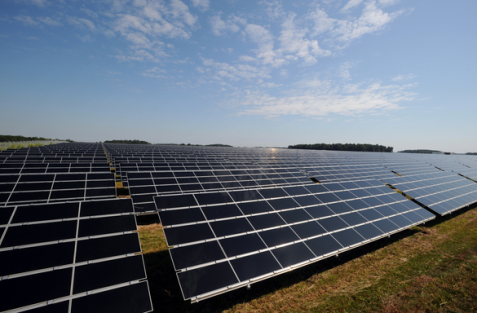 |
|
Data Acquisition - SCADA need to collect data from field equipments
such as PV Inverters, meter readings, environment sensors like
irradiation and temperature, string meters. These equipments are
communicated to PLCs or PC for data and status reports via
communication interface like RS485 or TCP. Data is then compiled and
formatted in such a way that a workstation operator using the HMI
can make supervisory decisions to adjust or override normal
controls. Data may also be fed to database and backup server, often
built on a commodity database management system or remote cloud
server to allow trending and other analytical auditing. |
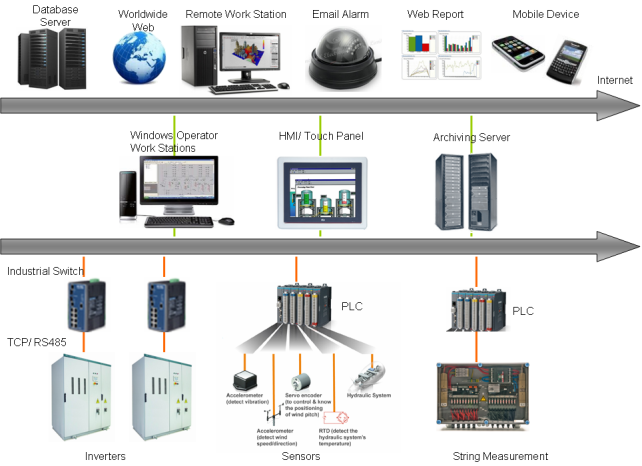 |
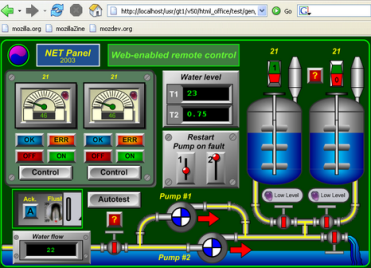 |
Human-Machine Interface - As data collect by SCADA system, it need to display the information
like light intensity, energy, and the power
generated on the farm per transformer unit and
delivery unit across the entire site by graphical
objects. It must be graphic intuitively that
operators or users can check the status quickly and
easily.
|
Remote Monitoring – In order to
prevent yielding loss, system administrators need to
be able to remotely check the yielding information,
inverter status, panel status, and environment
condition. SCADA system need to include web function
on it or support mobile devices. Once any events
happened, they can check it remotely to solve the
issue and handle the event in time.
Event and Alarm Management – SCADA system need to
alert users and system administrators to alarms and
system malfunctions. The function for sending and
receiving email messages, used in conjunction with
schedules, warns mobile operators according to their
availability.
Archiving – The SCADA system stores
the data acquired from the site concerning
production, maintenance, status, and reports, etc.
It needs to save in local workstation and also
backup to remote server for archiving.
Database – All the SCADA information need to export
to an SQL Server database for centralizing and
analyzing the production of the various farms. Users
or system administrators can apply the database to
query the history data in order to statistic or
analyze the performance of the solar plant. The
database can be setup in remotely cloud server or
locally database server.
Flexibility for Future Expansion – SCADA system must
keep the flexibility for future added solar panels,
inverters, environment sensors, string meters, or
other equipments.
|
|
|
What are the Differences between Utility and
Commercial Solar SCADA?
|
|
Usually, a utility scale solar plant is more than 5MW. A commercial solar plant
is from 10kW to 5MW. A commercial scale solar plant also needs the SCADA
function to make sure their solar plant keep working in good condition. The
commercial plant needs all SCADA function, but needs to be much lower cost than
utility one. In addition, commercial solar plant usually setup in government
organization, schools, and enterprises. Generating power is not the only
purpose, but they also need to show the information to people for demonstration
and education.
|
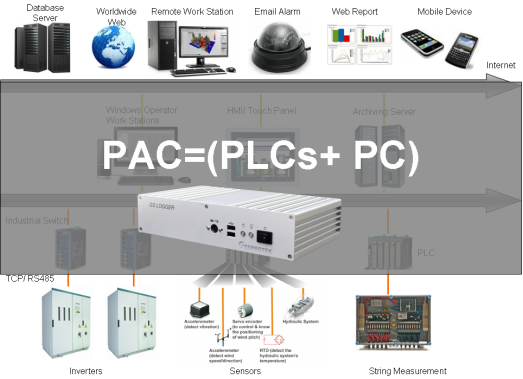 |
| A PAC system combines
with PLCs and PC function in one platform. It keeps both the
PLC’s stability and PC’s calculation abilities at the same time.
It provides the necessary functions of a SCADA system, but also
needs to help system installers can setup in shortest time and
help customer fulfill their demonstration function. It needs to
be a standardize and modularize platform with the integration
flexibility and future expansion ability. A commercial SCADA
system needs to have following features: |
• Need to have all
function as utility scale SCADA.
• Need to be a more cost effective way than utility scale SCADA.
• Need to be a standardize and stable solution.
• Need to have more flexibility and future expansion.
• Need to have more powerful function on demonstration.
|
|
|
Market Trend
Utility-Scale & Commercial-Scale Lead PV Market
Growth
|
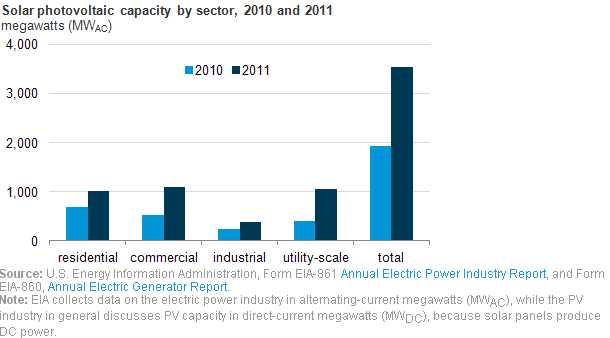
|
According to EIA's new survey-based estimate of total solar
capacity, total on-grid photovoltaic (PV) capacity nearly doubled in
2011, led by particularly strong growth in both utility-scale PV and
commercial sector PV capacity. Although 2011 was a record year for
solar PV growth, solar PV capacity has consistently grown over the
past few years. The Interstate Renewable Energy Council (IREC) reports that
total grid-connected PV capacity quadrupled between 2008 and 2011.
|
|




